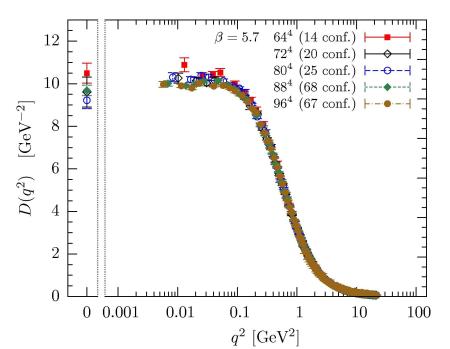There is currently a lot of activity to understand the behavior of the two-point functions in a Yang-Mills theory when quarks are not considered. The relevance of these results relies on the possibility to get working tools to manage low-energy phenomenology of QCD. E.g. we know quite well that the Nambu-Jona-Lasinio model is very successful to describe the behavior of hadronic matter and this model can be easily derived from full QCD if one knows the gluon propagator and the behavior of the ghost field. This idea dates back to a paper by Terry Goldman and Richard Haymaker (see here) on 1981. This can be summed up by saying that: given the gluon propagator one can get back a Nambu-Jona-Lasinio model. One could be able to derive it directly from QCD and this would be a great achievement explaining a lot of work done in several decades by a lot of smart researchers.
In these days it seems that we have to cope with a couple of scenarios and long lasting debate is still alive about them. One of this, the conformal solution, has been supported by a lot of researchers for a long period of time, making sometime very difficult for other scenarios to be commonly accepted and being published on archival journals. The conformal solution is easy to describe with the following sentences:
- The gluon propagator goes to zero at lower momenta.
- The ghost propagator goes to infinity at lower momenta faster than the free case.
Supporters of this solution also claimed that the running coupling reaches a fixed point at zero momenta. This fixed point was strongly lowered as lattice computations easily showed that things do not stay this way.
Indeed, lattice computations showed without doubt, increasing the volume, as the gluon propagator reaches a finite value at zero momenta and never converges toward zero. The ghost propagator is seen to behaves exactly as that of a free particle. But notwithstanding such an evidence, much effort is still devoted to understand why the conformal solution is not seen in such computations. A lot of hypotheses were put forward to explain why Yang-Mills propagators do not behave in such a well acquired way.
Axel Maas had a bright idea on this way to understand. He turned his attention to the D=2 model on the lattice (see here). Nobody did this before as this model is known to be trivial as it has no dynamics at all. This was proved by ‘t Hooft long ago. Maas showed that the 2D model on the lattice gives back the conformal solution. This means that a Yang-Mills model without dynamics has two-point functions behaving like those of the conformal solution. Most people saw this as a strong support to the conformal solution but things should be seen the other way round. Removing dynamics makes the conformal solution appear and lattice computations in 3 and 4d, that use the same code, are telling us the right behavior of the two-point functions. This is a serious setback for this approach and my personal view should be that any effort to further support this kind of solution should be abandoned as is a loss of resources and precious time. But this could be a very difficult choice for a lot of people that for a long time worked on this and contributed to create this scenario.
In my opinion, the most severe drawback of this solution is that it goes against the original idea by Goldman and Haymaker that the gluon propagator should give back the Nambu-Jona-Lasinio model. Indeed, the conformal solution does not even give back a mass gap and it is practically useless to answer to a lot of open questions in the low-energy phenomenology. In some way it remembers to me the position of the bootstrap model against the gauge paradigm that in the end proved to be the more fruitful approach. The last paper by Cucchieri and Mendes (see here) proves without doubt that the right form is a sum of Yukawa propagators and this gives back immediately a Nambu-Jona-Lasinio model.
As I cannot see reasons for people supporting the conformal solution to surrender, I think a lot of time will pass yet before truth will be acquired. Meantime, we stay here looking at the fight between such strong contenders.
, which allows one to study the implications of the most general spin-flavor structure of the quark forces.



 Posted by mfrasca
Posted by mfrasca 






